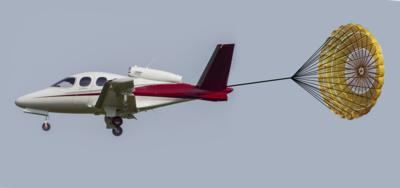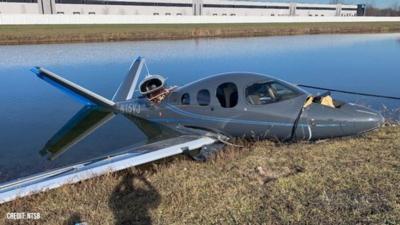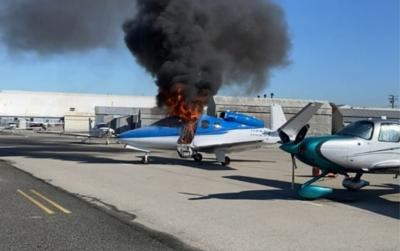Trap Chuting
Special 04.01.23 Parody Edition: The Cirrus Airframe Parachute System (CAPS) is a whole-plane Ballistic Parachute Recovery System (BPRS) developed by Ballistic Recovery Systems (BRS). The system, designed specifically for Cirrus Aircraft's SR20, SR22, and SF50 aircraft models, derives of the GARD (General Aviation Recovery Device) initially conceived of for the Cessna 150. The system received FAA certification in October 1998 and remains, to date, the only BPRS offered as standard equipment by an aerospace concern.

Cirrus’s CAPS architecture comprises a small solid-fuel rocket-booster which pulls the system’s parachute from a housing in the host aircraft’s aft cabin and helps fully deploy the ballistic-nylon canopy within seconds. The pilot-activated CAPS is designed to bring imperiled aircraft to ground at a descent-rate conducive to the survival of human beings, not airframes—necessarily.
Cirrus AFMs suggest deployment of CAPS in instances of engine failure, loss of aircraft control, midair collision, and aircraft structural damage—or under such circumstances as the PIC determines safety of flight is threatened or uncertain. In the event of pilot incapacitation, the CAPS can be activated by any aircraft occupant capable of applying the requisite 45-pounds of downward force to the system’s actuation lever.
Proper deployment of CAPS is predicated largely upon airspeed, altitude, and pilot judgment. The system must be activated at airspeeds less than the host aircraft’s published parachute deployment speed (Vpd)—which ranges, by model, from 135 to 140-KIAS. CAPS minimum deployment altitudes are set forth in the flight manuals of Cirrus aircraft. Instances in which CAPS has been activated at speeds less than the host aircraft’s Vpd and at altitudes above 400-AGL in straight-and-level flight (and 920-feet AGL in spins) have resulted in zero fatalities.
As of 11 March 2023, 143 total CAPS deployments have resulted in 122 aircraft saves and 249 survivors. The 21 deployment disparity comprises six anomalies in which the system malfunctioned due to internal or external factors, 14 non-saves resultant of CAPS deployment at low altitudes, and one non-save resultant of CAPS deployment at excessive speed.
Viewed through the lens of mathematics, a record of 122 saves in 143 deployments constitutes an 85-percent success-rate and reflects favorably on Cirrus’s CAPS.

Regrettably, the company’s SF-50 Vision Jet has acquitted itself less admirably. To date, seven of the Ultra-Light, single-engine jets have met inauspicious ends by disparate and distressing avenues. Two SF-50s have burned down on airport ramps, once at ZRH in September 2018 and once at SMO in December 2019. Another Vision Jet burned in August 2021 after a rejected takeoff at LAN resulted in a catastrophic fire. Yet another SF-50 was laid low after its nose-gear collapsed following a landing at Chicago’s MDW in August 2022. In still another, weirder instance, an SF-50 hangared at JWN was destroyed in March 2020 when a tornado ripped across the airport.
Of particular interest are two instances in which SF-50 Vision Jets were destroyed following CAPS deployments.
On 25 November 2022, an SF-50 G2, registration N15VJ, came down in a retention pond when its pilot activated the aircraft’s CAPS shortly after takeoff from Indianapolis Regional Airport’s (MQJ) runway 25. The SF-50 pilot reported receiving visual and aural gear unsafe warnings followed by an uncommanded aircraft up-pitching and reduction of engine power. Subsequent unsuccessful attempts to disconnect the jet’s autopilot and auto-throttle systems compelled the pilot to activate the SF-50’s CAPS. The parachute deployed and the airplane drifted down, coming to rest less than one-nautical-mile southwest of the departure end of MQJ runway 25 in the aforementioned retention pond.

On 09 September 2022, a Cirrus SF-50 Vision Jet, registration N77VJ, encountered allegedly severe turbulence while on approach to Florida’s Kissimmee Gateway Airport (ISM). For reasons as-of-yet unknown, the SF-50’s pilot deployed the CAPS, thereby initiating a sequence of events that brought the airplane down into a marshy wooded area near the eastern shore of Lake Toho.
The Vision Jet’s three passengers, an adult male and female and a minor male, were recovered and transported to a nearby hospital—representatives of which later reported the woman had sustained serious but non-life-threatening injuries. The condition of the male passengers was categorized as fair.
On 01 April 2023, Cirrus Aircraft—citing a disproportionately high instance of fires, runway overruns, acts of God, and generally lackluster luck—announced that SF-50 Vision Jets built after serial number 449 will feature not one, but two independent CAPS installations.
Cirrus Aircraft CEO Zean Nielsen stated: “It’s a Collier Trophy-winning design, but as with all high-performance aircraft, it demands respect. By provisioning the next generation of SF-50 Vision Jets with redundant CAPS, Cirrus Aircraft seeks to afford its customers an even higher degree of safety and security.”
Unlike the original system which was actuated by pulling a single red handle installed above the pilot’s left shoulder, the new CAPS layout comprises handles located at the upper, outboard position of every pilot and occupant seat. The updated design, intended to improve equity, allows any passenger so inclined to deploy the initial CAPS parachute at any phase of flight—from pre-takeoff taxi, to upwind climb, to cruise, to short final. The second CAPS parachute, however, may be deployed only from the left cockpit seat—traditionally occupied by the flying pilot.
The nearly one-hundred-pound increase to the weight of the SF-50 airframe occasioned by the addition of a second CAPS compelled Cirrus engineers back to the proverbial drawing board. The new system’s 65-foot diameter parachute is fully ten feet larger than that of the legacy design. What’s more, deployment of the larger, heavier parachute requires a commensurately larger, more powerful rocket booster. For purpose of ensuring the larger parachute canopy inflates fully, the new system’s line-cutter fuses have been delayed to ten-seconds.
Serendipitously, the new CAPS, owing to the increased size and speedier deployment of its parachute, facilitates a slower whole-aircraft descent rate than the legacy system.
Speaking to the subject of the newly redundant CAPS, Cirrus chief engineer Paul Johnston remarked: “There’s a right way and a wrong way to do things, and this is one of them.”
Whether or not Cirrus intends to develop an STC by which older SF-50 aircraft may be retrofitted with the redundant CAPS remains to be seen. Cirrus has, however, announced that the new system will be revealed to the public at AirVenture 2023.
 ANN's Daily Aero-Term (05.07.24): Hazardous Weather Information
ANN's Daily Aero-Term (05.07.24): Hazardous Weather Information ANN's Daily Aero-Linx (05.07.24)
ANN's Daily Aero-Linx (05.07.24) Airborne 05.01.24: WACO Kitchen, FAA Reauthorization, World Skydiving Day
Airborne 05.01.24: WACO Kitchen, FAA Reauthorization, World Skydiving Day Airborne Affordable Flyers 05.02.24: Bobby Bailey, SPRG Report Cards, Skydive!
Airborne Affordable Flyers 05.02.24: Bobby Bailey, SPRG Report Cards, Skydive! Airborne 05.03.24: Advanced Powerplant Solutions, PRA Runway Woes, Drone Racing
Airborne 05.03.24: Advanced Powerplant Solutions, PRA Runway Woes, Drone Racing





